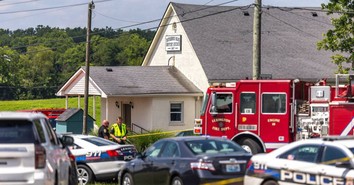First Person: The American Dream

I’m not exactly sure why, but it gets me every time.
Friday-night lights trumpet the weekly arrival of bubbly cheerleaders, glistening band instruments and enough adolescent testosterone and estrogen to fuel the Indy 500. It is an evening of glory and of fight songs, a place where pigskin flies and a thousand hopes per hour are realized and dashed.
For the most part, high school football games are predictable, but then suddenly, a familiar cadence rises from the marching band while the drill team rhythmically waves a sea of pom-poms in the air. Fans clap in metrical unison as a signal of anticipation and approval.
And then it happens. The football team runs out on the field led by a player carrying a large American flag.
Now I love my country as much as the next person, but I’m not generally known for my zealous patriotism. And most of my close friends would tell you that I’m not a sentimental woman, a crier who predictably weeps at movies or at Hallmark television commercials. Still, every single time I witness this grand entrance at a football game I find myself profoundly choked up. I have spent several years wondering why.
I got to thinking that perhaps my Pavlovian response is rooted in a profound sense of sadness over how September 11th changed the soul of this nation. But after much reflection I don’t think that’s it. Week after week as the flag-bearing team runs on to the field, I try to put a firm finger on why it nearly moves me to tears. And while I haven’t yet discovered the great “A-ha,” I do seem to be getting warmer. I suspect it has something to do with the American Dream.
A quick search of the worldwide web yields several definitions for “The American Dream,” most of which say essentially the same thing: “Americans’ hope for a better quality of life and a higher standard of living than their parents.” Wow. That leaves room for a lot of interpretation. Are we talking bigger houses and faster cars? Plastic surgery and more credit cards? Is the American Dream about escaping a third-world country and building a successful family business on American soil, or could it simply be the triumph of rising above the emotional and spiritual poverty in which one was raised?
No matter what the circumstances, everyone has an ideal that was formed by what they have lived through. And that’s not terribly surprising. Like it or not we all – to some degree – are pragmatists. Not only do we learn from our own mistakes; we have also learned from our parents’ mistakes, and are typically resolute in our determination not to repeat them. It’s a noble, but somewhat lofty ambition, to be sure.
But I’ve been intrigued of late by another ideal, one that seems to have been formed by a marriage of modern evangelicalism and good old American materialism – complete with Norman Rockwell as the officiant. You might call it “the good life.” If I were to draw a composite of “the good life,” it might look something like this: Dad puts in a good 8-to-5, and mom is busy shuttling kids to private schools, music lessons and sports practice. They have great insurance plans, bulging savings and retirement accounts, and at least one SUV. Dad coaches the soccer team and teaches Sunday school, while mom is the homeroom mother and volunteer-at-large for various church and community causes. They’re very well dressed with a beautifully furnished home, take exciting trips, and their kids are model citizens and high achievers. These folks are the poster children for what you, too, can have if you’ll just follow Jesus.
Trouble is, I’ve been a follower of Christ for nearly 25 years, and my life has never looked much like that—though I nearly died trying.
The American Dream found me at the tender age of 20, earnestly trying to carve out a better plot than the one from which I came. Call it Eden in suburbia, salvation in second chances, the promised land of 2.5 kids, a mortgage and the notion that I was going to do it “right.” I married in the fall of my 20th year, and we made quite a pair: two young, broken, newly regenerated know-it-alls with just enough information to be annoying and dangerous. To say we were idealistic and naïve would be putting it mildly.
If I had known what the next 23 years would hold I may not have been so confidently optimistic. It has been a sometimes rapturous, oftentimes agonizing odyssey. Marriage and parenthood have not been my ticket to “happily-ever-after.” Rather, they have been divine tools in the hand of a Ruthless Surgeon, scalpels that have exposed and extracted things slyly hidden behind a hallowed veneer of poise and composure. (Just so you know, this is not a minor surgical procedure.)
Over the years I’ve gone at least 15 rounds with the story of my past, working out my salvation with fear and trembling as I face things I hoped would miraculously disappear upon conversion. (Much like the Israelites in the wilderness, I have found this deliverance to be gradual, not instantaneous.) I have been a part of many church communities; some have profoundly blessed me, others have deeply wounded me, but all have shaped me. Finally – and perhaps most significantly – I have wrestled intensely with a God who has been merciful enough not to let me succeed in building the life I set out to.
Though I will admit that in some ways I know much less now than I did 23 years ago, one thing I can say with absolute certainty is that none of these things have looked like “the good life” when I was going through them. But I suspect that they more closely resemble “good” than anything I could have dreamed.
At the end of the day, I suspect that most American Dreams can be traced back to one universal thing: the hope that someday everything will finally be okay. It’s an understandable longing, as a yearning for Eden seems to be deeply fused into human DNA But we all know that the problem with wanting to live in a perfect world, of course, is that we don’t. Things will never be okay this side of heaven. I’ve known this in theory, but truth be told, even though I’m a follower of Christ I’ve spent plenty of time chasing a dream that has done little more than run me into the ground.
The ground is a popular place to learn that there’s an enormous difference between good living and living “the good life.” And as crazy as it may sound, perhaps it’s that hard-won knowledge that creeps up into my throat when I see a group of fresh, robust teens chasing a symbol of the American Dream onto a playing field. Many will be tackled, and an unfortunate few may even have to be carried off on a stretcher. Still, there’s glory in the game.
Laura Harris, a freelance writer/songwriter, wife and mother of three daughters, lives in Austin, Texas.
Originally published January 04, 2005.







